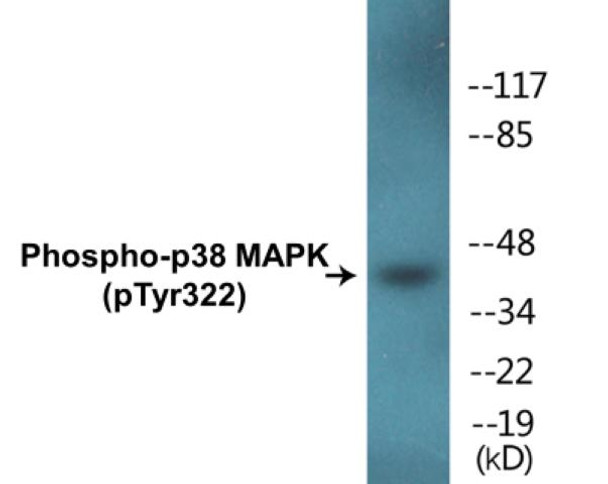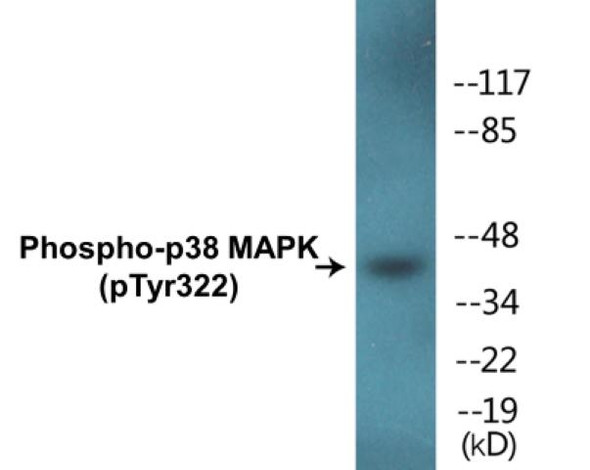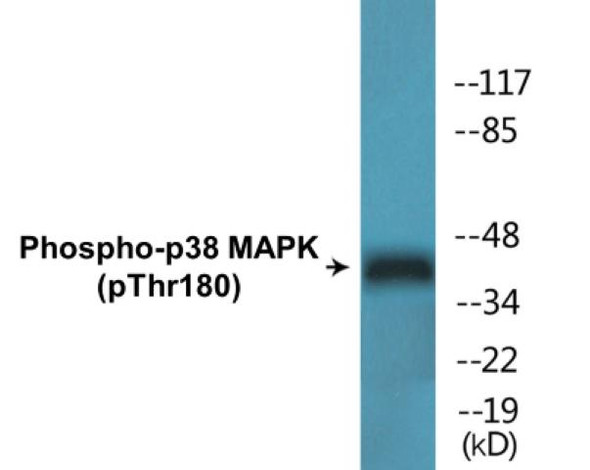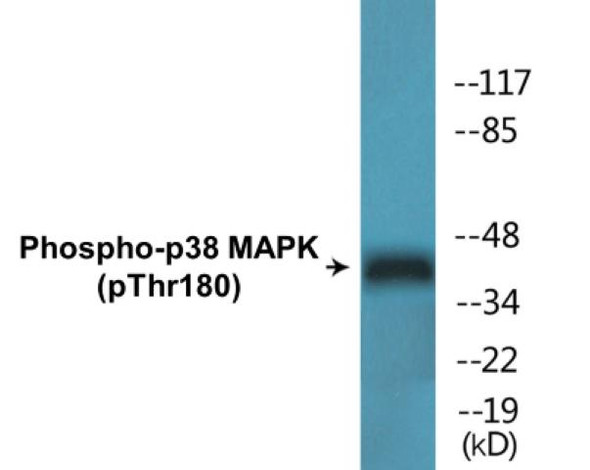Description
p38 MAPK (Phospho-Tyr322) Cell-Based ELISA Kit
The p38 MAPK (Phospho-Tyr322) Cell-Based ELISA Kit is a convenient, lysate- free, high throughput and sensitive assay kit that can monitor p38 MAPK phosphorylation and expression profile in cells. The kit can be used for measuring the relative amounts of phosphorylated p38 MAPK in cultured cells as well as screening for the effects that various treatments, inhibitors (ie. siRNA or chemicals), or activators have on p38 MAPK phosphorylation.
How does our p38 MAPK (Phospho-Tyr322) Fluorometric Cell-Based ELISA Kit work?
Qualitative determination of p38 MAPK (Phospho-Tyr322) concentration is achieved by an indirect ELISA format. In essence, p38 MAPK (Phospho-Tyr322) is captured by p38 MAPK (Phospho-Tyr322)-specific primary (1°) antibodies while Dye 1-conjugated and Dye 2-conjugated secondary (2°) antibodies bind the Fc region of the 1° antibody. Through this binding, the dye conjugated to the 2° antibody can emit light at a certain wavelength given proper excitation, hence allowing for a fluorometric detection method. Due to the qualitative nature of the Cell-Based ELISA, multiple normalization methods are needed:
| 1. | A monoclonal antibody specific for human GAPDH is included to serve as an internal positive control in normalizing the target RFU values. |
| 2. | An antibody against the nonphosphorylated counterpart of p38 MAPK (Phospho-Tyr322) is also provided for normalization purposes. The RFU values obtained for non-phosphorylated p38 MAPK can be used to normalize the RFU value for phosphorylated p38 MAPK. |
p38 MAPK (Phospho-Tyr322) Fluorometric Cell-Based ELISA Kit -Information
| Product Name: | p38 MAPK (Phospho-Tyr322) Fluorometric Cell-Based ELISA Kit |
| Product Code/SKU: | FBCAB00047 |
| Description: | The p38 MAPK (Phospho-Tyr322) Fluorometric Cell-Based Phospho ELISA Kit is a convenient, lysate-free, high throughput and sensitive assay kit that can monitor p38 MAPK (Phospho-Tyr322) protein phosphorylation and expression profile in cells. The kit can be used for measuring the relative amounts of phosphorylated p38 MAPK (Phospho-Tyr322) in cultured cells as well as screening for the effects that various treatments, inhibitors (ie. siRNA or chemicals, or activators have on MAPK14 phosphorylation. |
| Dynamic Range: | > 5000 Cells |
| Detection Method: | Fluorometric |
| Storage/Stability: | 4°C/6 Months |
| Reactivity: | Human, Mouse, Rat |
| Assay Type: | Cell-Based ELISA |
| Database Links: | Gene ID: 1432, UniProt ID: Q16539, OMIM #: 600289, Unigene #: Hs.485233/Hs.588289 |
| Format: | Two 96-Well Plates |
| NCBI Gene Symbol: | MAPK14 |
| Sub Type: | Phospho |
| Target Name: | Phospho-p38 MAPK (Tyr322) |
Kit Principle
Figure: Schematic representation of Assay Genie Cell-Based Fluorometric ELISA principle
Kit components | Quantity |
| 96-Well Black Cell CultureClear-Bottom Microplate | 2 plates |
| 10X TBS | 24 ml |
| Quenching Buffer | 24 ml |
| Blocking Buffer | 50 ml |
| 15X Wash Buffer | 50 ml |
| Primary Antibody Diluent | 12 ml |
| 100x Anti-Phospho Target Antibody | 60 µl |
| 100x Anti-Target Antibody | 60 µl |
| Anti-GAPDH Antibody | 110 µl |
| Dye-1 Conjugated Anti-Rabbit IgG Antibody | 6 ml |
| Dye-2 Conjugated Anti-Mouse IgG Antibody | 6 ml |
| Adhesive Plate Seals | 2 seals |
Additional equipment and materials required
The following materials and/or equipment are NOT provided in this kit but are necessary to successfully conduct the experiment:
- Fluorescent plate reader with two channels at Ex/Em: 651/667 and 495/521
- Micropipettes capable of measuring volumes from 1 µl to 1 ml
- Deionized or sterile water (ddH2O)
- 37% formaldehyde (Sigma Cat# F-8775) or formaldehyde from other sources
- Squirt bottle, manifold dispenser, multichannel pipette reservoir or automated microplate washer
- Graph paper or computer software capable of generating or displaying logarithmic functions
- Absorbent papers or vacuum aspirator
- Test tubes or microfuge tubes capable of storing ≥1 ml
- Poly-L-Lysine (Sigma Cat# P4832 for suspension cells)
- Orbital shaker (optional)
Kit Protocol
This is a summarized version of the kit protocol. Please view the technical manual of this kit for information on sample preparation, reagent preparation and plate lay out.
| 1. | Seed 200 µl of desired cell concentration in culture medium into each well of the 96-well plates. For suspension cells and loosely attached cells, coat the plates with 100 µl of 10 µg/ml Poly-L-Lysine (not included) to each well of a 96-well plate for 30 minutes at 37°C prior to adding cells. |
| 2. | Incubate the cells for overnight at 37°C, 5% CO2. |
| 3. | Treat the cells as desired. |
| 4. | Remove the cell culture medium and rinse with 200 µl of 1x TBS, twice. |
| 5. | Fix the cells by incubating with 100 µl of Fixing Solution for 20 minutes at room temperature. The 4% formaldehyde is used for adherent cells and 8% formaldehyde is used for suspension cells and loosely attached cells. |
| 6. | Remove the Fixing Solution and wash the plate 3 times with 200 µl 1x Wash Buffer for 3 minutes. The plate can be stored at 4°C for a week. |
| 7. | Add 100 µl of Quenching Buffer and incubate for 20 minutes at room temperature. |
| 8. | Wash the plate 3 times with 1x Wash Buffer for 3 minutes each time. |
| 9. | Dispense 200 µl of Blocking Buffer and incubate for 1 hour at room temperature. |
| 10. | Wash 3 times with 200 µl of 1x Wash Buffer for 3 minutes each time. |
| 11. | Add 50 µl of Primary Antibody Mixture P to corresponding wells for p38 MAPK (Phospho-Tyr322) detection. Add 50 µl of Primary Antibody Mixture NP to the corresponding wells for total p38 MAPK detection. Cover the plate with parafilm and incubate for 16 hours (overnight) at 4°C. If the target expression is known to be high, incubate for 2 hours at room temperature. |
| 12. | Wash 3 times with 200 µl of 1x Wash Buffer for 3 minutes each time. |
| 13. | Add 50 ul of Secondary Antibody Mixture to corresponding wells and incubate for 1.5 hours at room temperature in the dark. |
| 14. | Wash 3 times with 200 µl of 1x Wash Buffer for 3 minutes each time. |
| 15. | Read the plate(s) at Ex/Em: 651/667 (Dye 1) and 495/521 (Dye 2). Shield plates from direct light exposure. |
| 16. | Wash 3 times with 200 µl of 1x Wash Buffer for 5 minutes each time. |
p38 MAPK (Phospho-Tyr322) - Protein Information
| UniProt Protein Function: | P38A: a proline-directed ser/thr MAP kinase, and one of four p38 kinases that play important roles in cellular responses to inflammatory cytokines, DNA damage, oxidative stress, and some GPCRs, leading to direct activation of transcription factors and of other downstream kinases including MSK1, MSK2, eEF2K, MK2, and PRAK. MSK1 and -2 play important roles in the rapid induction of immediate-early genes in response to stress or mitogenic stimuli. MK2 and -3 control gene expression mostly at the post-transcriptional level. eEF2K is important for the elongation of mRNA during translation. Ectodomain shedding of transmembrane proteins is regulated by p38 MAPKs as well. In response to inflammatory stimuli, p38 MAPKs phosphorylate the membrane-associated metalloprotease ADAM17, which then cleaves the ectodomain of TGF-alpha family ligands, a process leading to the activation of EGFR signaling and cell proliferation. In the nucleus, many transcription factors are phosphorylated and activated by p38 MAPKs in response to different stimuli. Classical examples include ATF1, ATF2, ATF6, ELK1, PTPRH, CHOPO, p53 and MEF2C and MEF2A. The p38 MAPKs are emerging as important modulators of gene expression by regulating chromatin modifiers and remodelers. The promoters of several genes involved in the inflammatory response, such as IL6, IL8 and IL12B, display a p38 MAPK-dependent enrichment of histone H3 phosphorylation on 'Ser-10' (H3S10ph) in LPS-stimulated myeloid cells. Interacts directly with HDAC3 interacts directly and selectively to repress ATF2 transcriptional activity, and regulate TNF gene expression in LPS-stimulated cells. Phosphorylates the ubiquitin ligase SIAH2, regulating its activity towards EGLN3. May also inhibit the lysosomal degradation pathway of autophagy by interfering with the intracellular trafficking of the transmembrane protein ATG9. Regulates the endocytosis of membrane receptors that depend on RAB5A. Regulates the clathrin-mediated internalization of EGFR induced by inflammatory cytokines and UV irradiation by phosphorylating the EGFR and RAB5A effectors. Required in mid-fetal development for the growth of embryo-derived blood vessels in the labyrinth layer of the placenta. Plays an essential role in developmental and stress-induced erythropoiesis, through regulation of EPO gene expression. Interacts with casein kinase II subunits CSNK2A1 and CSNK2B. Activated by cell stresses such as DNA damage, heat shock, osmotic shock, anisomycin and sodium arsenite, as well as pro-inflammatory stimuli such as LPS and IL-1. Phosphorylated by ZAP70 in an alternative activation pathway in response to TCR signaling in T-cells, a pathway is inhibited by GADD45A. Four alternatively spliced isoforms of the human protein have been observed. Isoform MXI2 activation is stimulated by mitogens and oxidative stress and only poorly phosphorylates ELK1 and ATF2. Isoform EXIP may play a role in the early onset of apoptosis |
| UniProt Protein Details: | Protein type:Protein kinase, CMGC; EC 2.7.11.24; Kinase, protein; Protein kinase, Ser/Thr (non-receptor); CMGC group; MAPK family; p38 subfamily; MAPK/p38 subfamily Chromosomal Location of Human Ortholog: 6p21.3-p21.2 Cellular Component: nucleoplasm; spindle pole; mitochondrion; cytoplasm; cytosol; nucleus Molecular Function:MAP kinase activity; MAP kinase kinase activity; protein serine/threonine kinase activity; protein binding; NFAT protein binding; ATP binding Biological Process: nerve growth factor receptor signaling pathway; activation of MAPK activity; stress-activated MAPK cascade; toll-like receptor 3 signaling pathway; osteoclast differentiation; toll-like receptor 5 signaling pathway; cell surface receptor linked signal transduction; regulation of transcription factor activity; transmembrane receptor protein serine/threonine kinase signaling pathway; chondrocyte differentiation; toll-like receptor 4 signaling pathway; cartilage condensation; platelet activation; mitochondrion organization and biogenesis; skeletal muscle development; transcription, DNA-dependent; positive regulation of blood vessel endothelial cell migration; glucose metabolic process; toll-like receptor 2 signaling pathway; regulation of transcription from RNA polymerase II promoter; muscle cell differentiation; response to muramyl dipeptide; DNA damage checkpoint; striated muscle cell differentiation; positive regulation of transcription from RNA polymerase II promoter; fatty acid oxidation; toll-like receptor 9 signaling pathway; myoblast cell differentiation involved in skeletal muscle regeneration; apoptosis; cell morphogenesis; chemotaxis; signal transduction; toll-like receptor 10 signaling pathway; lipopolysaccharide-mediated signaling pathway; angiogenesis; MyD88-independent toll-like receptor signaling pathway; positive regulation of erythrocyte differentiation; organelle organization and biogenesis; DNA damage response, signal transduction; positive regulation of myoblast differentiation; MyD88-dependent toll-like receptor signaling pathway; peptidyl-serine phosphorylation; positive regulation of protein import into nucleus; Ras protein signal transduction; toll-like receptor signaling pathway; innate immune response; positive regulation of muscle cell differentiation; gene expression; cell motility; vascular endothelial growth factor receptor signaling pathway; blood coagulation |
| NCBI Summary: | The protein encoded by this gene is a member of the MAP kinase family. MAP kinases act as an integration point for multiple biochemical signals, and are involved in a wide variety of cellular processes such as proliferation, differentiation, transcription regulation and development. This kinase is activated by various environmental stresses and proinflammatory cytokines. The activation requires its phosphorylation by MAP kinase kinases (MKKs), or its autophosphorylation triggered by the interaction of MAP3K7IP1/TAB1 protein with this kinase. The substrates of this kinase include transcription regulator ATF2, MEF2C, and MAX, cell cycle regulator CDC25B, and tumor suppressor p53, which suggest the roles of this kinase in stress related transcription and cell cycle regulation, as well as in genotoxic stress response. Four alternatively spliced transcript variants of this gene encoding distinct isoforms have been reported. [provided by RefSeq, Jul 2008] |
| UniProt Code: | Q16539 |
| NCBI GenInfo Identifier: | 2499600 |
| NCBI Gene ID: | 1432 |
| NCBI Accession: | Q16539.3 |
| UniProt Secondary Accession: | Q16539,O60776, Q13083, Q14084, Q8TDX0, A6ZJ92, A8K6P4 B0LPH0, |
| UniProt Related Accession: | Q16539 |
| Molecular Weight: | 41,293 Da |
| NCBI Full Name: | Mitogen-activated protein kinase 14 |
| NCBI Synonym Full Names: | mitogen-activated protein kinase 14 |
| NCBI Official Symbol: | MAPK14 |
| NCBI Official Synonym Symbols: | RK; p38; CSBP; EXIP; Mxi2; CSBP1; CSBP2; CSPB1; PRKM14; PRKM15; SAPK2A; p38ALPHA |
| NCBI Protein Information: | mitogen-activated protein kinase 14; MAP kinase 14; p38alpha Exip; p38 MAP kinase; MAP kinase Mxi2; MAP kinase p38 alpha; CSAID-binding protein; Csaids binding protein; MAX-interacting protein 2; stress-activated protein kinase 2A; p38 mitogen activated protein kinase; mitogen-activated protein kinase p38 alpha; cytokine suppressive anti-inflammatory drug binding protein; cytokine suppressive anti-inflammatory drug-binding protein |
| UniProt Protein Name: | Mitogen-activated protein kinase 14 |
| UniProt Synonym Protein Names: | Cytokine suppressive anti-inflammatory drug-binding protein; CSAID-binding protein; CSBP; MAP kinase MXI2; MAX-interacting protein 2; Mitogen-activated protein kinase p38 alpha; MAP kinase p38 alpha; Stress-activated protein kinase 2a |
| Protein Family: | MIP-related peptides |
| UniProt Gene Name: | MAPK14 |
| UniProt Entry Name: | MK14_HUMAN |







